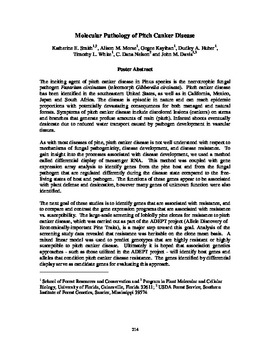| dc.contributor.author | Smith, K. E. | |
| dc.contributor.author | Morse, A. M. | |
| dc.contributor.author | Kayihan, G. | |
| dc.contributor.author | Huber, D. A. | |
| dc.contributor.author | White, T. L. | |
| dc.contributor.author | Nelson, C. D. | |
| dc.contributor.author | Davis, J. M. | |
| dc.date.accessioned | 2016-04-25T19:36:08Z | |
| dc.date.available | 2016-04-25T19:36:08Z | |
| dc.date.issued | 2003 | |
| dc.identifier | oksd_sf27_p214.pdf | |
| dc.identifier.citation | Smith, K. E., Morse, A. M., Kayihan, G., Huber, D. A., White, T. L., Nelson, C. D., & Davis, J. M. (2003). "Molecular Pathology of Pitch Canker Disease." In 27th Southern Forest Tree Improvement Conference, Stillwater, OK | |
| dc.identifier.uri | https://hdl.handle.net/11244/33705 | |
| dc.description.abstract | The inciting agent of pitch canker disease in Pinus species is the necrotrophic fungal pathogen Fusarium circinatum (teleomorph Gibberella circinata). Pitch canker disease has been identified in the southeastern United States, as well as in California, Mexico, Japan and South Africa. The disease is episodic in nature and can reach epidemic proportions with potentially devastating consequences for both managed and natural forests. Symptoms of pitch canker disease include discolored lesions (cankers) on stems and branches that generate profuse amounts of resin (pitch). Infected shoots eventually desiccate due to reduced water transport caused by pathogen development in vascular tissues. As with most diseases of pine, pitch canker disease is not well understood with respect to mechanisms of fungal pathogenicity, disease development, and disease resistance. To gain insight into the processes associated with disease development, we used a method called differential display of messenger RNA. This method was coupled with gene expression array analysis to identify genes from the pine host and from the fungal pathogen that are regulated differently during the disease state compared to the freeliving states of host and pathogen. The functions of these genes appear to be associated with plant defense and desiccation, however many genes of unknown function were also identified. The next goal of these studies is to identify genes that are associated with resistance, and to compare and contrast the gene expression programs that are associated with resistance vs. susceptibility. The large-scale screening of loblolly pine clones for resistance to pitch canker disease, which was carried out as part of the ADEPT project (Allele Discovery of Economically-important Pine Traits), is a major step toward this goal. Analysis of the screening study data revealed that resistance was heritable on the clone mean basis. A mixed linear model was used to predict genotypes that are highly resistant or highly susceptible to pitch canker disease. Ultimately it is hoped that association genetics approaches - such as those utilized in the ADEPT project - will identify host genes and alleles that condition pitch canker disease resistance. The genes identified by differential display serve as candidate genes for evaluating this approach. | |
| dc.format | application/pdf | |
| dc.language | en_US | |
| dc.relation.ispartofseries | Sponsored publication . . . of the Southern Forest Tree Improvement Committee ; no. 49 | |
| dc.rights | This paper is made available through open access and the auspices of the fair use doctrine for scholarly, educational and research purposes while recognizing the publisher already offers a free online version. The OSU Library�s intent is to offer access and preserve publications involving its faculty contributions. Contact the Digital Resources and Discovery Services at lib-dls@okstate.edu or 405-744-9161 for the permission policy on the use, reproduction or distribution of this material. | |
| dc.source | Proceedings of the 27th Southern Forest Tree Improvement Conference, volume 27, 2003. Editor, Craig R. McKinley. | |
| dc.title | Molecular Pathology of Pitch Canker Disease | |
| dc.type | text | |
| osu.filename | oksd_sf27_p214.pdf | |
| dc.type.genre | Conference proceedings | |
| dc.description.scopeandcontents | Papers and abstracts from the 27th Southern Forest Tree Improvement Conference held at Oklahoma State University in Stillwater, Oklahoma on June 24-27, 2003. | |
